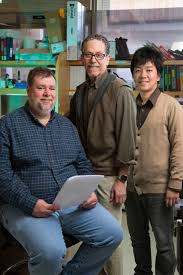Salk Institute scientist and serial biotech entrepreneur Ron Evans showed new mouse work yesterday that could point to a long-sought holy grail for diabetes treatment.
The study, published in Nature, involved a new approach for islet cell transplant, a diabetes therapy where dysfunctional insulin-producing cells on the pancreas are replaced with functional ones. The treatment has been around for a while and new ones are in development, but they’ve been hampered by the fact that patients will reject the cells unless they go on immuno-suppressive drugs.
But, working with iPSC stem cells and tricks from immunotherapy, Evans and his team developed what they called “immune-evasive” clusters of cells — essentially mini pancreases. Placed into mice, these cells secreted proper amounts of insulin without coming under fire from immune cells, pointing the way toward a similar approach in humans.
“Most type 1 diabetics are children and teenagers,” Evans said in a statement. “We hope that regenerative medicine in combination with immune shielding can make a real difference in the field by replacing damaged cells with lab-generated human islet-like cell clusters that produce normal amounts of insulin on demand.”
Evans, who most recently co-founded and sold to Astellas the “exercise-in-a-pill” biotech Mitobridge, and his co-authors are hardly alone in this race. ViaCyte has received major backing from both private donors and the Juvenile Diabetes Research Foundation for their own stem cell-derived islet cell transplant. Flagship also launched Sigilon earlier this year with $80.3 million in Series B funding. With technology from Robert Langer, the company is developing polymers that can encase cells for transplant. A diabetes program is in the IND-enabling phase with Eli Lilly.
Four years ago, Evans and his team figured out how to make functional pancreatic beta cells for the first time, using a series of molecular switches to get them to not only produce insulin but do so in response to glucose, as normal cells do. But that still left questions about how to go from individual cells into pancreas-like clusters, and how to get those cells to avoid the immune system when transplanted.
To cluster the cells, Evans’ lab figured out that a protein involved in embryonic development called WNT4 could trigger the same molecular mechanisms that created the functional beta cells. Adding that protein led to the creation of 3-D clusters of cells similar to what would be seen in a humans. They called them human islet-like organoids, or HILOs.
 Evans, with Downes and Yoshihara
Evans, with Downes and Yoshihara
To make those organoids, Evans and Eiji Yoshihara, a scientist in his lab, stole a trick from another field: immuno-oncology. Using short pulses of a protein called interferon gamma, Yoshihara got the cells to express PD-L1.
The PD-L1 had the opposite effect of the PD-L1 inhibitors used in cancer. Rather than making sure T cells saw a tumor, they made sure T cells didn’t see the islet cells.
“This is the first study to show that you can protect HILOs from the immune system without genetic manipulation,” Michael Downes, an author on the paper, said. “If we are able to develop this as a therapy, patients will not need to take immune-suppressing drugs.”